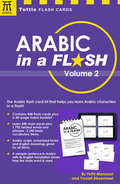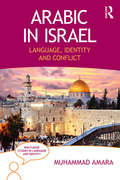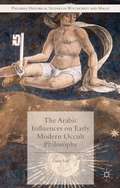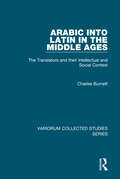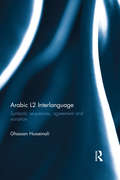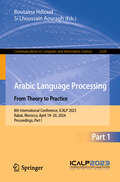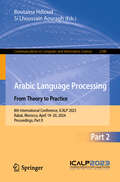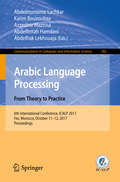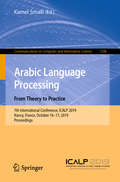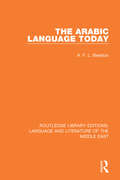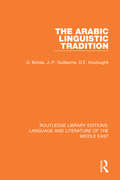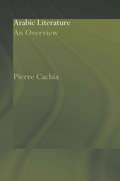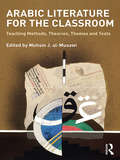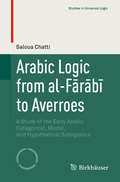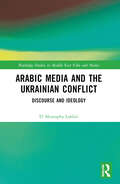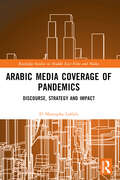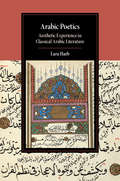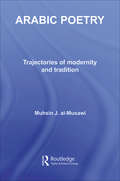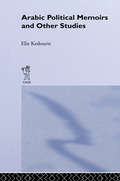- Table View
- List View
Arabic in a Flash Kit Volume 1
by Fethi MansouriArabic in a Flash: Volume I is an excellent new language learning resource for beginning students of Arabic.This unique set of flash cards enables learners to acquire basic Arabic words and their derivatives in an easy-to-use manner at whatever pace the learner prefers. Each card has Arabic script on one side, with romanized forms and English meanings/derivatives agiven on the other. Contains 448 flash cards plus a 32-page index booklet.Learn 448 main words plus 1,792 related words and phrases--2,700 basic vocabulary items.Arabic script, romanized forms and English meanings given for all items.A sample sentence in Arabic with English translation shows how the main word is used.
Arabic in a Flash Volume 2
by Fethi Mansouri Yousef AlreemawiArabic in a Flash: Volume 2 is an excellent language learning resource for beginning-intermediate students of Arabic.Hot on the success of Volume 1, Arabic in a Flash Volume 2 continues to develop the language skills of the beginning students and others interested in learning Arabic. While Volume 1 has a strong focus on basic communication and vocabulary-building, Volume 2 works to further develop vocabulary and introduces everyday activities, travel and leisure and economic and employment issues.Contains 448 flash cards plus a 48-page index booklet.Learn 448 main words plus 1,792 related words and phrases-2,240 basic vocabulary items.Arabic script, romanized forms and English meanings given for all items.A sample sentence in Arabic with its English translation shows how the main word is used.
Arabic in Israel: Language, Identity and Conflict (Routledge Studies in Language and Identity)
by Muhammad AmaraIn Arabic in Israel, Muhammad Amara analyses the status of Arabic following the creation of the State of Israel and documents its impact on the individual and collective identity of Israel’s Palestinian Arab citizens. The interplay of language and identity in conflict situations is also examined. This work represents the culmination of many years of research on Arabic linguistic repertoire and educational policy regarding the language of the Palestinian citizens of Israel. It draws all of these factors together while linking them to local, regional and global developments. Its perspective is interdisciplinary and, as such, examines the topic from a number of angles including linguistic, social, cultural and political.
Arabic in the City: Issues in Dialect Contact and Language Variation (Routledge Arabic Linguistics Series #Vol. 5)
by Catherine Miller Enam Al-Wer Dominique Caubet Janet C. E. WatsonFilling a gap in the literature currently available on the topic, this edited collection is the first examination of the interplay between urbanization, language variation and language change in fifteen major Arab cities. The Arab world presents very different types and degrees of urbanization, from well established old capital-cities such as Cairo to new emerging capital-cities such as Amman or Nouakchott, these in turn embedded in different types of national construction. It is these urban settings which raise questions concerning the dynamics of homogenization/differentiation and the processes of standardization due to the coexistence of competing linguistic models. Topics investigated include: History of settlement The linguistic impact of migration The emergence of new urban vernaculars Dialect convergence and divergence Code-switching, youth language and new urban culture Arabic in the Diaspora Arabic among non-Arab groups. Containing a broad selection of case studies from across the Arab world and featuring contributions from leading urban sociolinguistics and dialectologists, this book presents a fresh approach to our understanding of the interaction between language, society and space. As such, the book will appeal to the linguist as well as to the social scientist in general.
The Arabic Influences on Early Modern Occult Philosophy (Palgrave Historical Studies in Witchcraft and Magic)
by Liana SaifInvestigating the impact of Arabic medieval astrological and magical theories on early modern occult philosophy, this book argues that they provided a naturalistic explanation of astral influences and magical efficacy based on Aristotelian notions of causality.
Arabic into Latin in the Middle Ages: The Translators and their Intellectual and Social Context (Variorum Collected Studies)
by Charles BurnettThis collection of Charles Burnett's articles on the transmission of Arabic learning to Europe concentrates on the identity of the Latin translators and the context in which they were working. The articles are arranged in roughly chronological order, beginning with the earliest known translations from Arabic at the end of the 10th century, progressing through 11th-century translations made in Southern Italy, translators working in Sicily and the Principality of Antioch at the beginning of the 12th century, the first of the 12th-century Iberian translators, the beginnings and development of 'professional' translation activity in Toledo, and the transfer of this activity from Toledo to Frederick II's entourage in the 13th century. Most of the articles include editions of texts that either illustrate the style and character of the translator or provide the source material for his biobibliography.
Arabic Islamic Cities Rev: Building and Planning Principles
by Besim Selim HakimFirst published in 1989. Routledge is an imprint of Taylor & Francis, an informa company.
Arabic L2 Interlanguage: Syntactic sequences, agreement and variation (Topics in Arabic Applied Linguistics)
by Ghassan HusseinaliArabic L2 Interlanguage is a significant and timely addition to the field of Second Language Acquisition, providing valuable insight into the development of ‘interlanguage’, the interim language of early beginners, in learners of Arabic. This book: Clearly establishes what interlanguage is and why it should form an important part of foreign language teaching Presents the reader with a sequence in which six English-speaking learners of Arabic acquire the language Makes use of the rich morphological and syntactic property of Arabic to offer a new perspective on the field of Second Language Acquisition. Arabic L2 Interlanguage contributes directly towards building a more comprehensive theoretical framework for explaining how L2s are acquired. It will be key text for SLA scholars as well as an important resource for graduate students in Linguistics and Foreign Language Teaching.
Arabic Language Processing: 8th International Conference, ICALP 2023, Rabat, Morocco, April 19–20, 2024, Proceedings, Part I (Communications in Computer and Information Science #2339)
by Boutaina Hdioud Si Lhoussain AouraghThis two-volume set, CCIS 2339 and CCIS 2340, constitutes the refereed proceedings of the 8th International Conference on Arabic Language Processing, ICALP 2023, held in Rabat, Morocco, during April 19–20, 2024. The 30 full papers and 11 short papers presented in these two volumes were carefully reviewed and selected from 107 submissions. The papers are organized in the following topical sections: Part I: Learning Arabic and dialectal and Sentiment Analysis; Advancements in Deep Learning for Arabic Language Processing: Generation, Translation, and QA. Part II: Linguistic Resources for Arabic NLP; Various analysis of Arabic.
Arabic Language Processing: 8th International Conference, ICALP 2023, Rabat, Morocco, April 19–20, 2024, Proceedings, Part II (Communications in Computer and Information Science #2340)
by Boutaina Hdioud Si Lhoussain AouraghThis two-volume set, CCIS 2339 and CCIS 2340, constitutes the refereed proceedings of the 8th International Conference on Arabic Language Processing, ICALP 2023, held in Rabat, Morocco, during April 19–20, 2024. The 30 full papers and 11 short papers presented in these two volumes were carefully reviewed and selected from 107 submissions. The papers are organized in the following topical sections: Part I: Learning Arabic and dialectal and Sentiment Analysis; Advancements in Deep Learning for Arabic Language Processing: Generation, Translation, and QA. Part II: Linguistic Resources for Arabic NLP; Various analysis of Arabic.
Arabic Language Processing: 6th International Conference, ICALP 2017, Fez, Morocco, October 11–12, 2017, Proceedings (Communications in Computer and Information Science #782)
by Abdelmonaime Lachkar Karim Bouzoubaa Azzedine Mazroui Abdelfettah Hamdani Abdelhak LekhouajaThis book constitutes revised selected papers from the 6th International Conference on Arabic Language Processing, ICALP 2017, held in Fez, Morocco, in October 2017. The 18 full papers presented in this volume were carefully reviewed and selected from 55 submissions. They were organized in topical sections named: machine translation systems; speech recognition and synthesis; text categorization, clustering and summarization; information retrieval systems; and Arabic NLP tools and applications.
Arabic Language Processing: 7th International Conference, ICALP 2019, Nancy, France, October 16–17, 2019, Proceedings (Communications in Computer and Information Science #1108)
by Kamel SmaïliThis book constitutes revised selected papers from the 7th International Conference on Arabic Language Processing, ICALP 2019, held in Nancy, France, in October 2019. The 21 full papers presented in this volume were carefully reviewed and selected from 38 submissions. They were organized in topical sections named: Arabic dialects and sentiment analysis; neural techniques for text and speech; modeling modern standard Arabic; resources: analysis, disambiguation and evaluation.
The Arabic Language Today (Routledge Library Editions: Language & Literature of the Middle East)
by A.F.L. BeestonThis book, first published in 1970, provides a description of the standard Arabic language used today as the universal means of written communication throughout the Arab world and in formal spoken communication (vernaculars differ both from each other and from the standard language). The principal emphasis is on syntax and morphology of which there exists no comprehensive account. Phonology and lexicon are treated briefly and there is a chapter on the script.
The Arabic Linguistic Tradition (Routledge Library Editions: Language & Literature of the Middle East)
by Georges Bohas Jean-Patrick Guillaume Djamel Eddine KouloughliThe importance and richness of the Arabic linguistic tradition, largely neglected by Western literature, is amply demonstrated by this book, first published in 1990. Written by three experts in the field, it provides us with a comprehensive survey of the historical constitution and theoretical structure of the Arabic linguistic tradition from its beginnings in the eighth century to its mature state around the fourteenth and fifteenth centuries. Besides grammar, the book covers such fields as rhetoric, grammatical semantics, and methodological issues, and pays particular attention to the most representative works of the classical period. It also has the unique benefit of containing the historical background.
Arabic Literature: An Overview (Culture and Civilization in the Middle East)
by Pierre CachiaAssuming no previous knowledge of the subject, Arabic Literature - An Overview gives a rounded and balanced view of Arab literary creativity. 'High' literature is examined alongside popular folk literature, and the classical and modern periods, usually treated separately, are presented together. Cachia's observations are not subordinated to any pre-formed literary theory, but describe and illustrate the directions taken, in order to present an overall picture of the field of relevance to the student of literature as well as to Arabists working in related fields.
Arabic Literature for the Classroom: Teaching Methods, Theories, Themes and Texts
by Mushin J al-MusawiArabic Literature for the Classroom argues for a more visible presence of Arabic within the humanities and social sciences, stressing the need to make Arabic literature available as a world literature, without damaging its own distinctive characteristics. The nineteen chapters which make up this book broach theoretical and methodical cultural concerns in teaching literatures from non-American cultures, along with issues of cross-cultural communication, cultural competency and translation. While some chapters bring out the fascinating and ever tantalizing connections between Arabic and the literatures of medieval Europe, others employ specific approaches to teaching particular texts, potential methodologies, themes and a variety of topics that can place Arabic widely in a vast swathe of academic application and learning. Topics that are explored include gender, race, class, trauma, exile, dislocation, love, rape, humor, and cinema, as well as issues that relate to writers and poets, women’s writing and the so called nahdah (revival) movement in the 19th Century. The comparative framework and multi-disciplinary approach means that this book injects new life into the field of Arabic Literature. It will therefore be an essential resource for students, scholars and teachers of Arabic Literature, as well as for anyone with an interest in learning more about Arabic culture.
Arabic Literature in the Post-Classical Period
by Roger Allen D. S. RichardsThe final volume of The Cambridge History of Arabic Literature explores the Arabic literary heritage of the little-known period from the twelfth to the beginning of the nineteenth century. Even though it was during this time that the famous Thousand and One Nights was composed, very little has been written on the literature of the period generally. In this volume Roger Allen and Donald Richards bring together some of the most distinguished scholars in the field to rectify the situation. The volume is divided into parts with the traditions of poetry and prose covered separately within both their 'elite' and 'popular' contexts. The last two sections are devoted to drama and the indigenous tradition of literary criticism. As the only work of its kind in English covering the post-classical period, this book promises to be a unique resource for students and scholars of Arabic literature for many years to come.
Arabic Literature to the end of the Umayyad Period
by A. F. L. Beeston T. M. Johnstone R. B. Serjeant G. R. SmithOriginally published in 1983, The Cambridge History of Arabic Literature was the first general survey of the field to have been published in English for over fifty years and the first attempted in such detail in a multi-volume form. The volumes of the History provide an invaluable source of reference and understanding of the intellectual, literary and religious heritage of the Arabic-speaking and Islamic world. This volume begins its coverage with the oral verse of the sixth century AD, and ends with the fall of the Umayyad dynasty two centuries later. Within this period fall major events: the life of the Prophet Muhammad, the founding of the Islamic religion, the great Arab Islamic conquests of territories outside the Arabian Peninsula, and their meeting, as overlords, with the Byzantine and Sasanian world. Contributors to this volume discuss an array of topics including the influences of Greeks, Persians and Syrians on early Arabic literature.
Arabic Logic from al-Fārābī to Averroes: A Study of the Early Arabic Categorical, Modal, and Hypothetical Syllogistics (Studies in Universal Logic)
by Saloua ChattiThis monograph explores the logical systems of early logicians in the Arabic tradition from a theoretical perspective, providing a complete panorama of early Arabic logic and centering it within an expansive historical context. By thoroughly examining the writings of the first Arabic logicians, al-Fārābī, Avicenna and Averroes, the author analyzes their respective theories, discusses their relationship to the syllogistics of Aristotle and his followers, and measures their influence on later logical systems. Beginning with an introduction to the writings of the most prominent Arabic logicians, the author scrutinizes these works to determine their categorical logic, as well as their modal and hypothetical logics. Where most other studies written on this subject focus on the Arabic logicians’ epistemology, metaphysics, and theology, this volume takes a unique approach by focusing on the actual technical aspects and features of their logics. The author then moves on to examine the original texts as closely as possible and employs the symbolism of modern propositional, predicate, and modal logics, rendering the arguments of each logician clearly and precisely while clarifying the theories themselves in order to determine the differences between the Arabic logicians’ systems and those of Aristotle. By providing a detailed examination of theories that are still not very well-known in Western countries, the author is able to assess the improvements that can be found in the Arabic writings, and to situate Arabic logic within the breadth of the history of logic. This unique study will appeal mainly to historians of logic, logicians, and philosophers who seek a better understanding of the Arabic tradition. It also will be of interest to modern logicians who wish to delve into the historical aspects and progression of their discipline. Furthermore, this book will serve as a valuable resource for graduate students who wish to complement their general knowledge of Arabic culture, logic, and sciences.
Arabic Media and the Ukrainian Conflict: Discourse and Ideology (Routledge Studies in Middle East Film and Media)
by El Mustapha LahlaliFocused on two renowned Arabic networks, Al-Jazeera and Al-Arabiyya, this book examines Arabic media discourses and strategies adopted in the coverage of the conflict in Ukraine.Providing an in-depth textual analysis of the coverage of the Russian-Ukrainian conflict, the book focuses on the types of discourse employed, key linguistic devices used, and the representation of different actors, whether directly or indirectly involved. This encompasses the attitudes and perceptions of Russians, Ukrainians, Europeans, Americans, and NATO, as well as the wider international community. The book aims to establish the inextricable link between language and the socio-cultural and political ideologies that contribute to the production of media discourse on conflicts. It is argued that some of these ideologies are represented through language, which itself reflects the networks' policies, the influence of their sponsors, and their individual stances towards the war.The book will be of interest to students and researchers in a range of fields, including Arabic and Middle Eastern Studies, Media and Communications, and Applied Linguistics, as well as to general readers interested in media’s coverage of conflicts.
Arabic Media Coverage of Pandemics: Discourse, Strategy and Impact (Routledge Studies in Middle East Film and Media)
by El Mustapha LahlaliFocused on two networks, Al-Jazeera and BBC Arabic, this study provides an in-depth quantitative and qualitative analysis of different media strategies employed in the coverage of Covid-19. The author draws primarily from Critical Discourse Analysis, supplemented by an analysis of corpora from both Al-Jazeera and BBC, comprising news items, documentaries and discussion shows. An array of key topics are examined for their language and lexis, including political leaders and governments, the public and victims of Covid-19. The two networks’ coverage of these topics are closely compared and contrasted, with both employing strategies of exemplification, nominalisation, functionalisation, naming and labelling. The analysis shows that the two networks have displayed a solidarity discourse throughout the pandemic, emphasising the need to fight the disease. In addition, the networks have consistently stressed the gravity of the pandemic, urging adherence to local regulations. It is ultimately argued that examining the coverage of Covid-19 from a dialectical perspective will enable us to unravel the social, cultural, political, and ideological motives behind the production of pandemic media discourse. The book will appeal to students and researchers in linguistics, media and communications, and Middle Eastern studies, as well as to general readers interested in conflict and pandemic response.
Arabic Philosophy
by Peter Adamson Richard C. TaylorRepresenting one of the great traditions of Western philosophy, philosophy written in Arabic and in the Islamic world was inspired by Greek philosophical works and the indigenous ideas of Islamic theology. This collection of essays, by some of the leading scholars in Arabic philosophy, provides an introduction to the field by way of chapters devoted to individual thinkers (such as al-Farabi, Avicenna and Averroes) or groups, especially during the 'classical' period from the ninth to the twelfth centuries.
Arabic Poetics: Aesthetic Experience in Classical Arabic Literature (Cambridge Studies in Islamic Civilization)
by Lara HarbWhat makes language beautiful? Arabic Poetics offers an answer to what this pertinent question looked like at the height of the Islamic civilization. In this novel argument, Lara Harb suggests that literary quality depended on the ability of linguistic expression to produce an experience of discovery and wonder in the listener. Analyzing theories of how rhetorical figures, simile, metaphor, and sentence construction are able to achieve this effect of wonder, Harb shows how this aesthetic theory, first articulated at the turn of the eleventh century CE, represented a major paradigm shift from earlier Arabic criticism which based its judgement on criteria of truthfulness and naturalness. In doing so, this study poses a major challenge to the misconception in modern scholarship that Arabic criticism was 'traditionalist' or 'static', exposing an elegant widespread conceptual framework of literary beauty in the post-eleventh-century Islamicate world which is central to poetic criticism, the interpretation of Aristotle's Poetics in Arabic philosophy and the rationale underlying discussions about the inimitability of the Quran.
Arabic Poetry: Trajectories of Modernity and Tradition (Routledge Studies in Middle Eastern Literatures)
by Muhsin J. al-MusawiSince the late 1940s, Arabic poetry has spoken for an Arab conscience, as much as it has debated positions and ideologies, nationally and worldwide. This book tackles issues of modernity and tradition in Arabic poetry as manifested in poetic texts and criticism by poets as participants in transformation and change. It studies the poetic in its complexity, relating to issues of selfhood, individuality, community, religion, ideology, nation, class and gender. Al-Musawi also explores in context issues that have been cursorily noticed or neglected, like Shi’i poetics, Sufism, women’s poetry, and expressions of exilic consciousness. Arabic Poetry employs current literary theory and provides comprehensive coverage of modern and post-modern poetry from the 1950s onwards, making it essential reading for those with interests in Arabic culture and literature and Middle East studies.
Arabic Political Memoirs and Other Studies
by Elie KedourieFirst Published in 2005. Routledge is an imprint of Taylor & Francis, an informa company.

